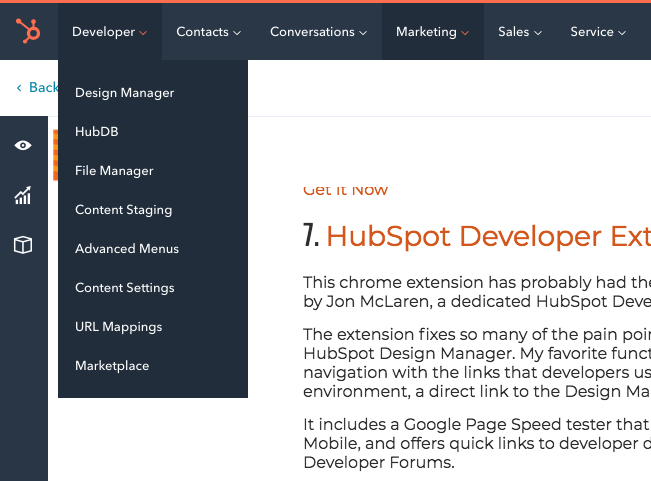 Today, I welcome my friend Matthew Russo as a guest on nateriggs.com. Matt is the co-founder of ChatterJet, a new online service that provides small and medium-sized business owners with customized daily content ideas, articles, and conversation starters that help get fans and followers chatting with the brand online. ChatterJet launched today in Columbus, Ohio!
Today, I welcome my friend Matthew Russo as a guest on nateriggs.com. Matt is the co-founder of ChatterJet, a new online service that provides small and medium-sized business owners with customized daily content ideas, articles, and conversation starters that help get fans and followers chatting with the brand online. ChatterJet launched today in Columbus, Ohio!
A teaching assistant once asked Albert Einstein, “Professor, which exam should I give the class at the end of this session?”
Einstein responded, “Give them the same test we used last year.”
“But professor, the questions on this year's exam will be the same as last!” the young man exclaimed.
“Yes,” Einstein answered, “but this year all the answers are different.”
The beauty of social media is that the answers are always changing. As businesses, we can monitor macro and micro trends within our industry by searching for and filtering customers, thought leaders, influencers, keywords and more.
Best of all, most of the tools to track and respond to these trends are at our finger tips – often times for free.
Today, I'm going to talk a little about how to capitalize on one underutilized social media resource that small businesses can use to identify and connect with potential customers consistently and quickly: Twitter Search.
Step 1: Start Broad
Let's say you're a car dealership looking to find some new customers using social media. You're a smart guy or gal, so you run a general query for cars in Columbus (cars near:43215) on Twitter Search and you get the following results:
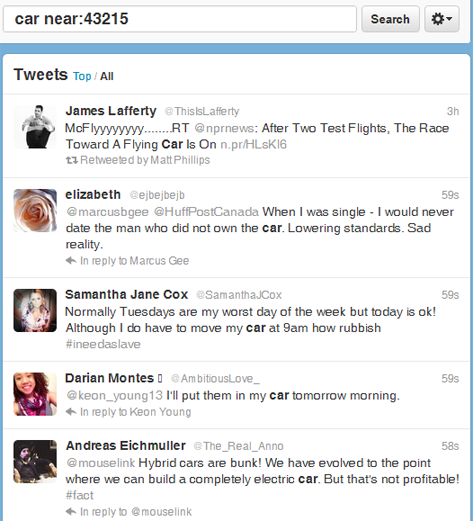
Pretty useless, huh? Not to worry. Quantity breeds quality, and with approximately 20 new tweets a minute, it shouldn't be to long until you find a nugget or two.
Step 2: Sift and Refine
As you browse through your list, you discover this gem:
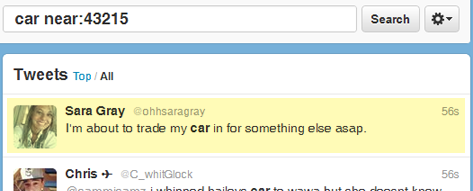
In under two minutes, you uncovered at least one potential lead for your dealership. Not too shabby.
But let's dig a little deeper. We're going to refine our search to include that exact phrase to see if her tweet is more than just an isolated event. (trade my car near:43215)
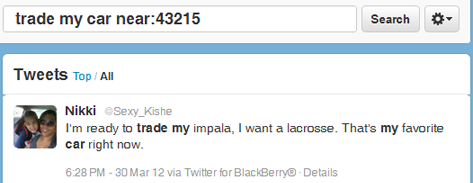
One other result, and it doesn't seem like she's quite ready to buy yet. But she definitely knows what she wants, and if your dealership sells the Buick Lacrosse then it would definitely be worth your time to reach out and invite her to the showroom.
Continue to modify your search by thinking like your customer & put yourself in their shoes. Use a diverse range of searches, working from broad to more specific terms. The more detailed you get, the less frequent the output will be. But they will be highly qualified opportunities to reach out and start a conversation with.
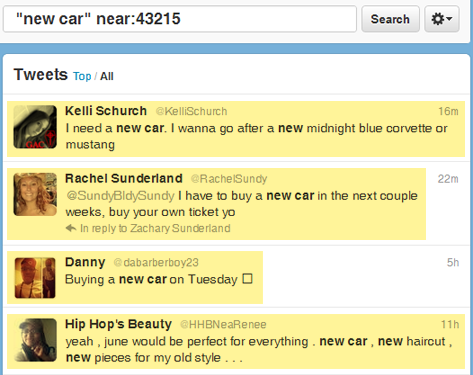
Step 3: Mind Your Competition
Many companies focus so narrowly on monitoring their own brand that they miss out on a larger opportunity. FourSquare is an incredibly well-formatted and useful way to keep tabs on your competition - and find new leads for your own company.
Often times, a search of “4sq.com + Competitor's Name” on Twitter will do the trick, but be creative and try different variations
This approach is a little reactive (it's better to be listening for opportunities earlier in your customer's life cycle before they visit your competition), but it is still a highly qualified source.
Step 4: Monitoring Systems
If you use a platform like HootSuite or TweetDeck, keeping track of each search is a snap. I would recommend adding a stream for each search - starting with the most targeted, infrequent terms (because they are the most qualified) and working your way out to more general terms that yield a lot of noise.
Step 4b: (Super Geeky) Advanced Monitoring
Don't have time to sit in front of the computer and watch the leads roll in all day long? Keep an eye on these searches on your smart phone throughout the day using services like Boxcar and respond each time a highly qualified lead posts an update.
No smart phone? No problem. There are a couple of solutions that let you grab the RSS feed of your searches and have the results sent to you via SMS text message.
Step 5: Follow Up & Interact Through Lists
Lead discovery through keyword search is just the tip of the iceberg.
In a battle for our attention, social media has trained many of us to pay attention to whatever sits at the top of our Twitter stream, Facebook timeline, lists, or RSS feed. But what if we were intentionally proactive and planned our actions in advance?
Separate yourself from your competition by adding the people you find through searches to lists. Studies have shown that it costs up to five times more money to acquire a new customer than it does to keep an existing one.
If that's true, why not create a Current Customers or Potential Leads list and use it to keep in touch with those who you have done (or hope to do) business with? Layer on top of that the life-cycle of your product or service and you can quickly build out a calendar of tweets months in advance, as well as a source for random serendipitous interaction.
Top of mind awareness for businesses has never been easier.
Remember, the purpose of using social media is not to create more work for ourselves; it is to put technology to work for us so that we can better leverage our time, make more connections, and establish real relationships with people who want and need our services - now and in the future.

-1.png)
